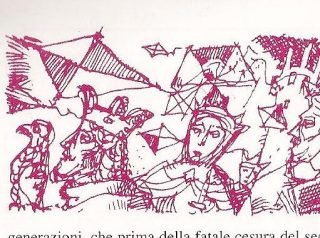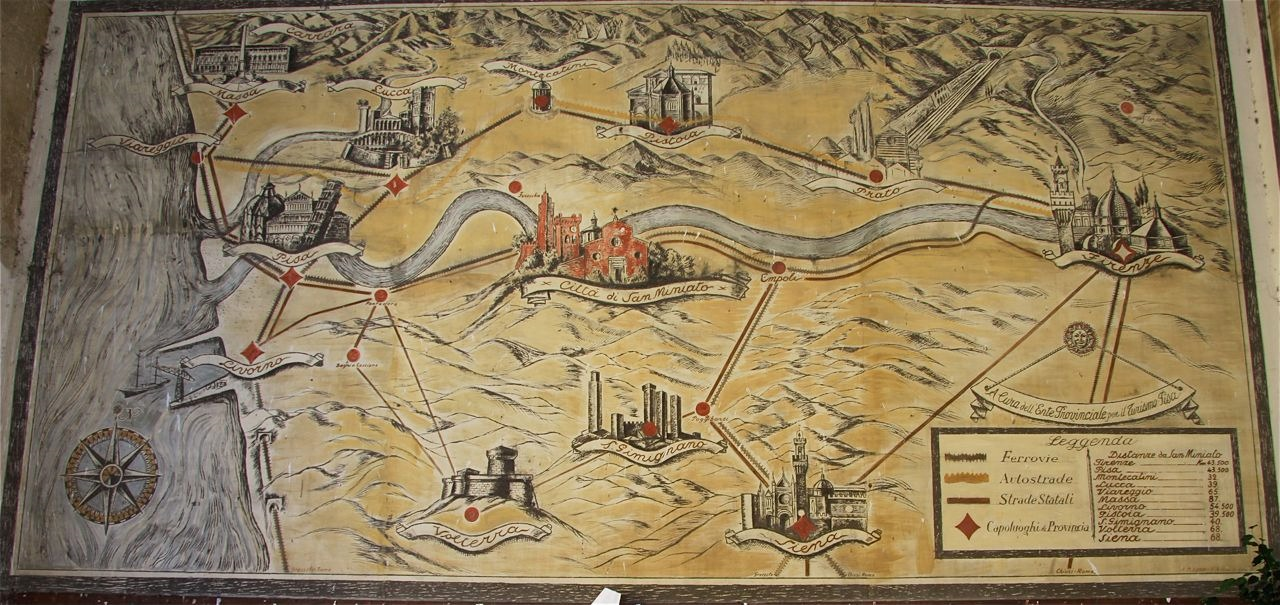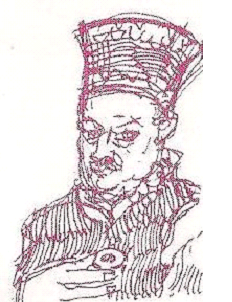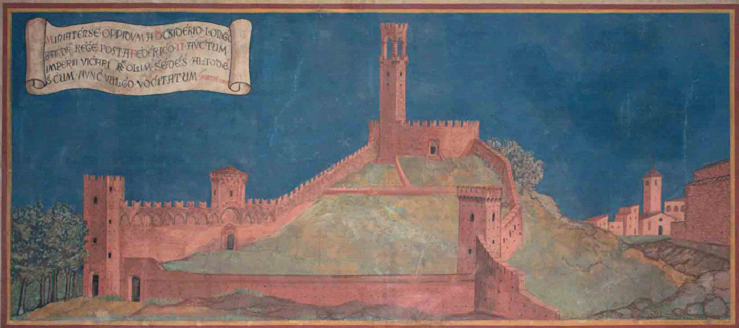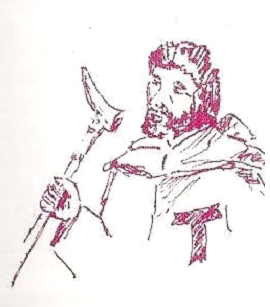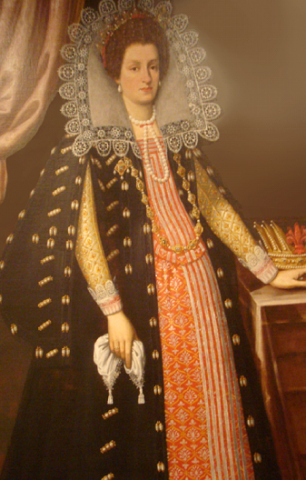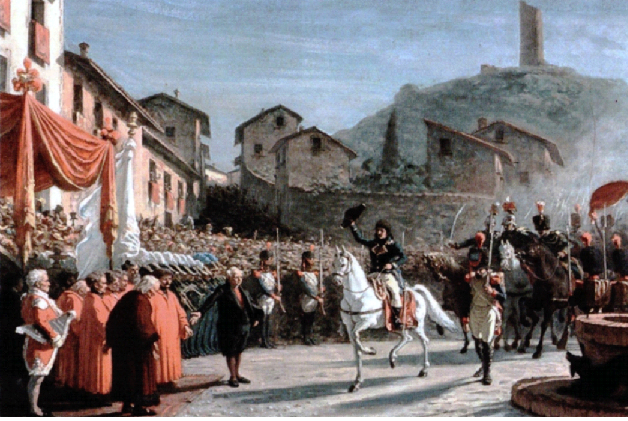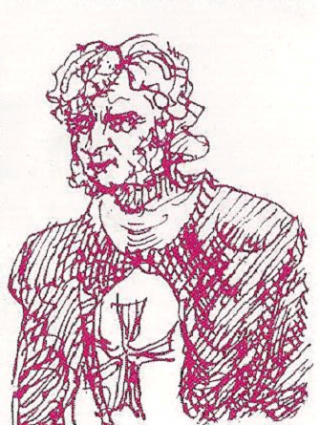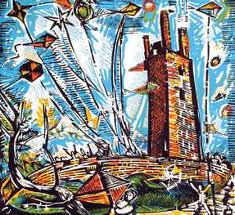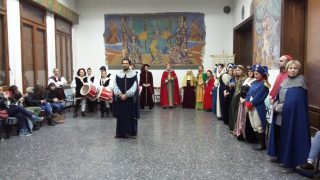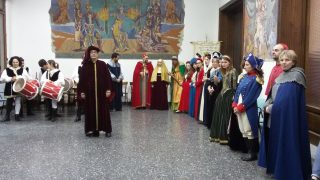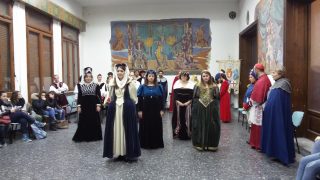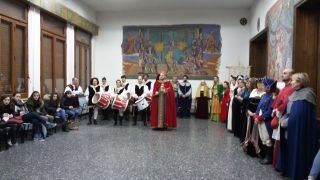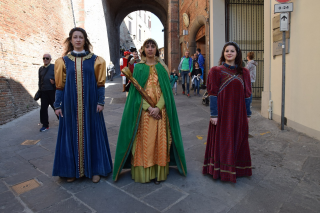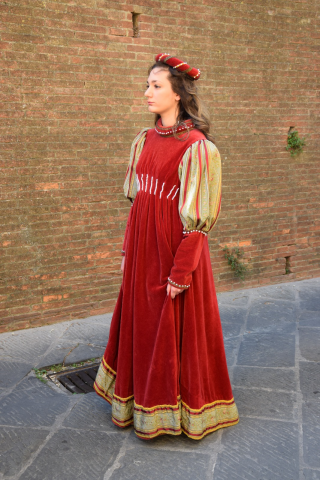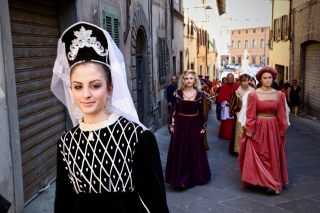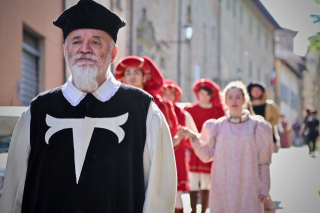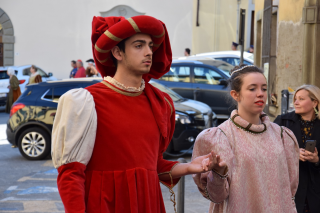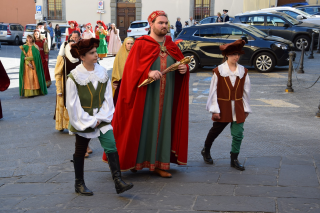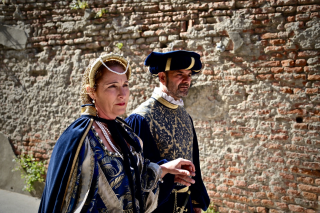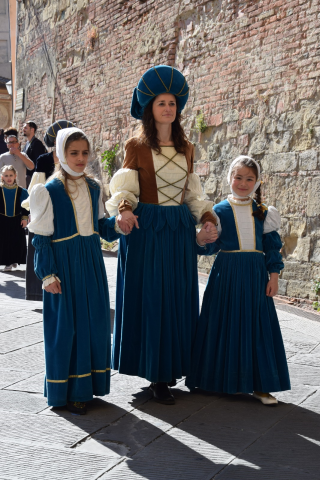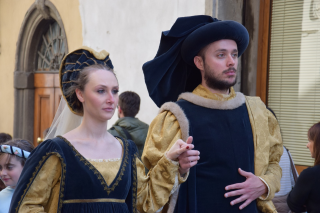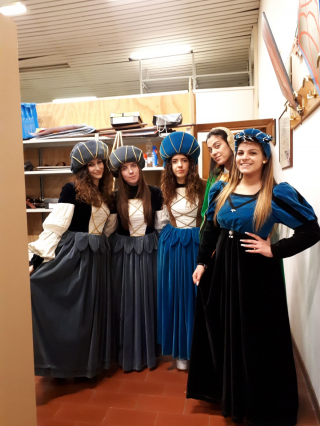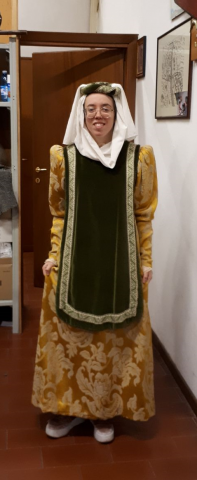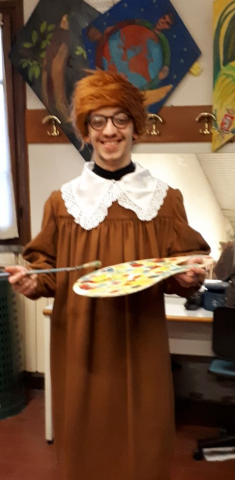Corteo Storico – San Miniato
CONTENT
Camarlengo – The Lord Chamberlain
Ladies and Pages
Costanza d’Altavilla
Frederick II
Pier delle Vigne
Teutonic Knight
Matilde of Canossa
Messer Barone Mangiadori
Priest of St. Anthony’s Order
Franco Sacchetti
Lena Pitti
Bruna di Poggighisi and Ser Alessandro Turri
Monsignor Ugolino Grifoni
Ludovico Cardi- Il Cigoli
Giovanni Bilivert
Maria Maddalena of Austria
Napoleon Bonaparte
Pietro Leopoldo II – Canapone
Monsignor Torello Pierazzi
The Corteo Storico of San Miniato is a historical costume parade which commemorates famous people who lived in San Miniato in the 13th and 14th centuries.
In this period San Miniato was divided into three parts, called “Terzieri”, and City Wards.
- Il Terziere di Poggighisi was divided into three city wards: Poggighisi, Pancole and Sant’Andrea
- Il Terziere di Castelvecchio was divided into two city wards: Santo Stefano and Castelvecchio.
- Il Terziere di Forisporta was divided into two city wards: Faognana and Forisporta.
Every city ward had its own Coats of Arms, soldiers and hospitals.
San Miniato was a free Commune and was governed by a “Podestà” and a “Capitano del Popolo”. It also had an Imperial Vicar and, later, a Florentine Vicar (14th century).
Camarlengo – The Lord Chamberlain
The Lord Chamberlain, who was a priest or a cardinal, administered the properties and the revenues of the Church.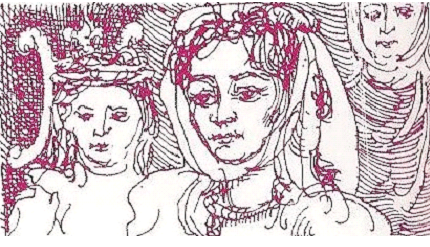
Ladies and Pages
They were men and women who served noble people in the Middle Ages.
Costanza d’Altavilla (1146-1198) 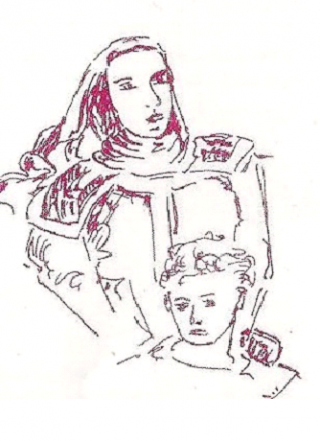
Costanza d’Altavilla was the last German heir of the Norman Kings of Sicily and the wife of Henry VI, the Holy Roman Emperor.
She was the daughter of Ruggero II, King of Sicily and married Henry VI, Frederick Barbarossa‘s son in 1186.
She was the Empress of Germany and the Queen of Sicily and reigned with her husband until 1186 when he died. In 1187 she reigned with her son Frederick II of Swabia, the future Holy Roman Emperor.
She died in 1198 when her son was seven years old so she left him under Pope Innocenzo III‘s protection.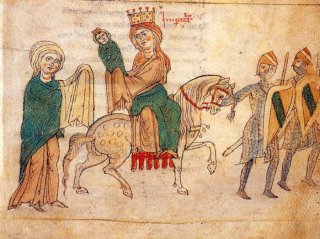
Frederick II (1194-1250) 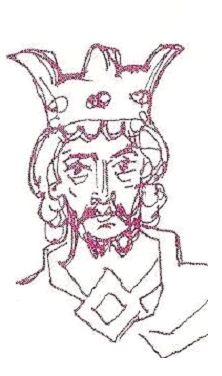
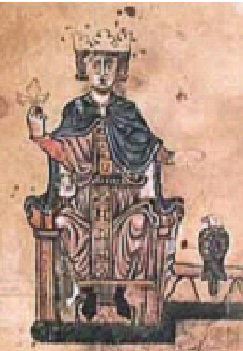
Frederick II was the grandson of Frederick Barbarossa and the son of Henry III, the Holy Roman Emperor. He was the King of Sicily and the Holy Roman Emperor.
He was a man of great culture and a highly significant European monarch in the Middle Ages .He built his castle in Piazza del Duomo in San Miniato in 1218.
He fortified the Fort, called La Rocca, and used it as a political prison. Frederick II imprisoned priests, cardinals, nobles and his friend, Pier delle Vigne, in the Fort in San Miniato.
Pier delle Vigne (1190-1249) 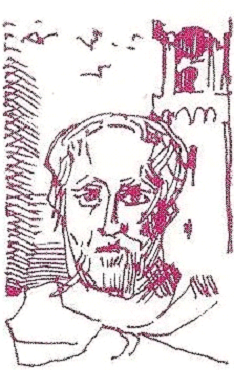
Pier delle Vigne was a writer and a diplomat. He was Frederick II‘s Secretary and Chancellor. He was charged with treason and imprisoned in the Fort in San Miniato in 1248. After a year in prison he was visited by the Emperor; he was unable to communicate or defend himself so the Emperor had his eyes ripped out.
Unable to bear it, he committed suicide in the Fort.
Pier delle Vigne is mentioned in the Divine Comedy by Dante Alighieri (Inferno, Canto XIII). He reveals Dante and Virgil his identity saying “ I am the man who held both the keys of Frederick’s heart…”. This means that Frederick II trusted him a lot. This sentence is written on a stone under the Fort in San Miniato.
Teutonic Knight 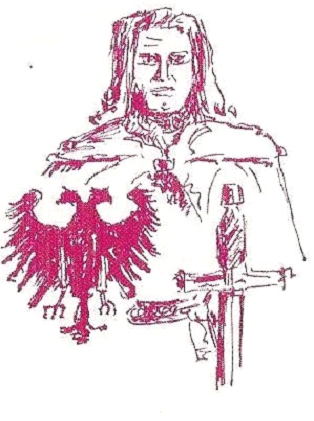
These German knights belonged to the Teutonic Order, a Medieval German military order. They served as knights in the Crusades. Frederick II was linked to them from the political and spiritual point of view.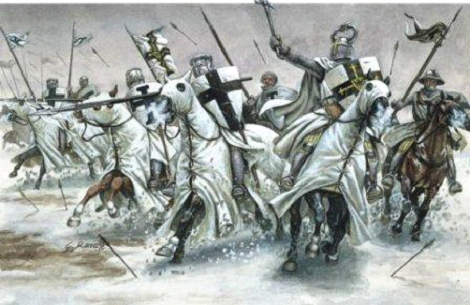
Matilde of Canossa (1046-1115) 
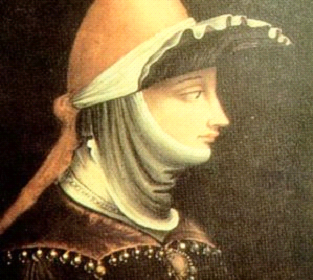
Matilde of Canossa was an Italian noblewoman. She was a great warrior and one of the few medieval women to be remembered for her military accomplishments. She is sometimes called the Great Countess.
She was the daughter of Bonifacio IV, ruler of many counties, such as Reggio, Modena, Mantua, Brescia and Ferrara, and Beatrice of Lorena, one of Frederick II’s daughters.
She was Countess of Tuscany and visited San Miniato many times. Probably she was born in San Miniato and lived in the Imperial Palace in Piazza del Duomo. She died in 1115.
Messer Barone Mangiadori 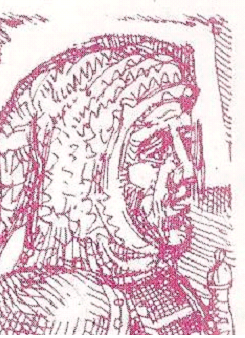
Messer Barone Mangiadori was a great and successful knight, who lived in San Miniato and became the “Podestà” of Siena. He fought in the battle of Campaldino (1289) ,a famous battle between the Guelphs and the Ghibellines. His palace, Magiadori Palace, was destroyed in 1369.
Priest of St. Anthony’s Order
He was a priest who belonged to St. Anthony’s Order. He was one of the priests who lived in St. Stephen’s Church in San Miniato and ran a hospital for the people who suffered from St. Anthony’s fire and leprosy (1352).
Franco Sacchetti (1334- 1400) 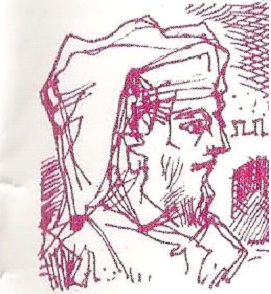
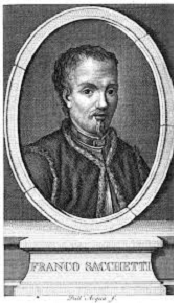
Franco Sacchetti was a writer, a poet and a novelist. He wrote “Trecento Novelle” (Three Hundred Tales) in the vernacular, the language of the common people.
Some of these tales are about San Miniato or are set in this town. He lived in San Miniato and was the “Podesta’” of San Miniato (1386).
Lena Pitti 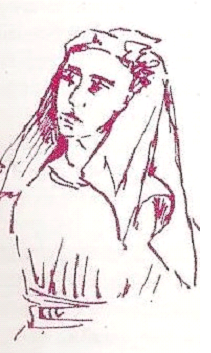
Lena Pitti was Jacopo Bonaparte’s wife so she belonged to the Bonaparte family.
Before dying she asked for a Holy Mass to be celebrated in the Sanctuary of the Holy Crucifix at dawn every day in order to commemorate her family whose members had been beheaded in Gargozzi at dawn.
Bruna di Poggighisi and Ser Alessandro Turri 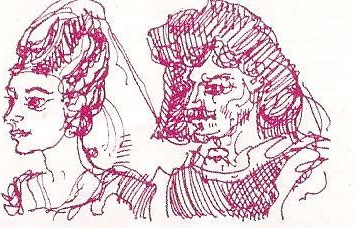
Bruna di Poggighisi and Ser Alessandro Turri are the protagonists of “La Bruna di Poggighisi–Storia Samminiatese del XVI secolo” by Guido Pieragnoli (1886).
Bianca (La Bruna) was an orphan and Ser Alessandro Turri, a nobleman from San Miniato adopted her. Bianca fell in love with a Spanish officer, Ruiz, but later she married Goro, a loyal compatriot.
The story is set in the period when San Miniato was besieged by Florentine and Spanish troops in the 16th century.
Monsignor Ugolino Grifoni(1504-1576) 
Monsignor Ugolino Grifoni was Alessandro and Cosimo I of the Medici Family’s Secretary.
He built two buildings, a Palace in Piazza Santissima Annunziata in Florence and a Palace in Piazza Grifoni in San Miniato. These buildings were created by famous artists such as Michelangelo, Giuliano di Baccio D’Angnolo, Buontalenti, Ammannati and Gianbologna.
Monsignor Ugolino Grifoni is buried in the Church of San Domenico in San Miniato.
Ludovico Cardi- Il Cigoli (1559-1613) 
Ludovico Cardi, whose nickname “Il Cigoli” derives from his birthplace, was born in Cigoli in 1559. He was a painter, a sculptor and an architect.
He worked at the Medici Family’s Court in Florence .He also worked on St. Peter’s Cathedral in Rome and frescoed Santa Maria Maggiore’s Chapel for Pope Paolo V. He is the best painter that San Miniato can boast.
Giovanni Bilivert (1576-1644) 
He was an Italian painter who worked in “Il Cigoli”’s workshop.
Maria Maddalena of Austria (1589-1631)
Maria Maddalena of Austria was Grand Duchess of Tuscany, Archduchess of Hasburg and Queen of San Miniato.
When her husband, Cosimo II of the Medici Family, died she reigned in Tuscany for eleven years.
San Miniato became the capital of her reign (1620-1631) and Palazzo Grifoni was her Royal Palace. She made San Miniato a bishop’s seat in 1622.
Her marble statue was placed in Piazza del Seminario, but it was destroyed in the 18th century.
Napoleon Bonaparte (1769-1821)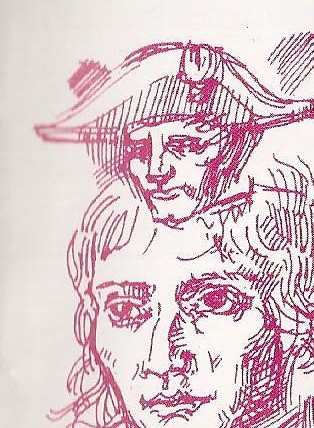
Napoleon Bonaparte, the famous Emperor of France, was born in Corsica but his family was of Italian noble origins and they had most of their properties in San Miniato. Napoleon came to San Miniato during his campaign in Italy in 1796 in order to meet Filippo Bonaparte, who was a priest and the Bonaparte family’s last descendant.
Napoleon’s wax Funeral Mask is housed in the Euteleti Academy in San Miniato. The Oratory of San Rocco was the ancient chapel of the Bonaparte family.
Pietro Leopoldo II – Canapone (1797-1870)
Pietro Leopoldo II was Grand Duke of Tuscany (1824-1859). He was called “Canapone” for his hair colour.
When he was in exile in Vienna, he was educated by Pietro Bagnoli, a priest and poet from San Miniato. He always had a good relationship with Pietro Bagnoli, his teacher.
He set up a lot of institutions such as state schools, the railway station and the Court of Justice in San Miniato.
A marble statue by Luigi Pampaloni was built in his honour in Piazza Bonaparte.
Monsignor Torello Pierazzi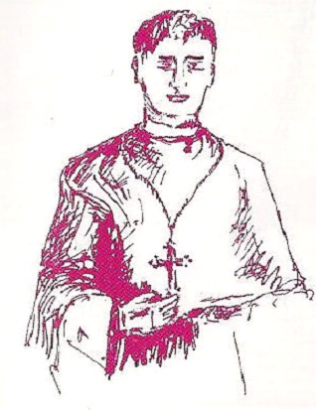

Monsignor Torello Pierazzi was a man of culture and an excellent priest. He was San Miniato’s Bishop from 1834 to 1851.He created a lot of important institutions, re-organized the Euteleti Academy and set up a library in the Palace of the Seminary.
Bibliografia: Dilvo Lotti “San Miniato Vita di un’antica Citta’”; “Corteo Storico di San Miniato” San Miniato Comitato Manifestazioni Popolari Sitografia : www.wikipedia.org;www.googleimmagini.it

